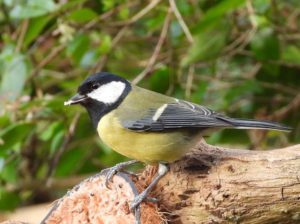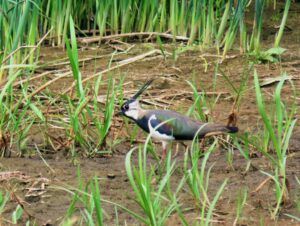The master plan for the February HBW trip was to find raptors in the South Downs at The Burgh near Amberley. One look out of the window when I awoke was enough to make me rack my brains for Plan B. It needed tea and corn flakes to help formulate this and to my mind Burton Mill Pond seemed sensible as there would be at least some protection from both wind and rain!
All five of us agreed Plan B was good and we set off. Or at least we nearly set off. I hadn’t picked up a message from Carole to say she could make it so we needed to take her car as well as mine and she took Tony. At some point in the proceedings I had said she could leave her car outside my house so she didn’t get a parking fine for being over 4 hours in the car park. I therefore set off and pulled up in front of Meadowside in Church Street expecting her to pull up behind me and leave her car. As I got out of my car to find out why this wasn’t happening Tony put his head out of Carole’s window to remind me that 5 minutes before we had agreed she would need to drive to the venue. How to impress a new member of HBW!
Now we did get going and just before Pulborough we turned on to the Rackham road to cut through to Burton Mill Pond. Half a mile down the road there was an unwelcome sign: ROAD CLOSED. My street cred (assuming I ever had any) appeared to me to be diminishing rapidly. Nonetheless, with Pulborough Brooks on the doorstep a rapid decision to go there was reached. By this time I was mentally exhausted!!
On arrival I was immediately put back on my feet when Tony gleefully announced he was thrilled to be there as it was his first visit. After all the early mishaps we got straight down to birdwatching rather than beginning with coffee which is the usual group requirement. Sue knew the reserve well and directed us to the feeding station just off the main track and this was delightful. So many Great Tits!  They were all in splendid plumage and at one point I counted five round the feeders. There were Blue Tits, a couple of Long Tailed Tits and a glorious male Greenfinch with his more soberly attired partner. Goldfinches were chattering somewhere close by and Chaffinch, Robin and Dunnock pottered around the ground picking up scraps. We spent quite a while there and were rewarded by the arrival of a smart-looking Nuthatch. I was derogatory about the white Doves which fluttered in but Hilary felt I was being very unfair to them and I had to agree that they did look quite nice.
They were all in splendid plumage and at one point I counted five round the feeders. There were Blue Tits, a couple of Long Tailed Tits and a glorious male Greenfinch with his more soberly attired partner. Goldfinches were chattering somewhere close by and Chaffinch, Robin and Dunnock pottered around the ground picking up scraps. We spent quite a while there and were rewarded by the arrival of a smart-looking Nuthatch. I was derogatory about the white Doves which fluttered in but Hilary felt I was being very unfair to them and I had to agree that they did look quite nice.
We tore ourselves away and headed downhill towards the water. Everywhere looked flooded but at least it wasn’t raining on us. We all hoped we might find Siskins or Redpolls on the way down and we turned off to the area where the birds are fed near some outbuilding with food hidden in crevices and woodpiles near a copse which includes pine and alder trees. Ideal habitat for our quarry but unfortunately not today. It was still entertaining watching the small birds finding food and hearing the early song from Dunnock, Robin and Wren.
We moved on towards the first hide after an unsuccessful search for Treecreepers in a couple of likely looking old oak trees. The water was really high so little chance of waders but surprise, surprise a Snipe gave really close up views and eventually we picked out one or two more a little further off. Two Stonechats obligingly took up look out posts along an adjacent fence giving us good views. This was Shoveler City and there were also groups of other duck species. I think Hilary was worried I was going to test her on all of them but I thought better of it (because I tend to get confused with some of the females!). However we chalked up Gadwall, Mallard, Teal, Wigeon and Tufted Duck along with Canada Goose and some far distant Mute Swans. Lapwings showed well and sometimes spooked themselves enough to fly up en masse.

Leaving the hide we found a Kestrel and then, finding worms in a field, were a small mixed group of Redwing and Fieldfare. We didn’t strike lucky with White-Tailed Eagle but while trying to ID some small birds from another hide there was a high speed but unsuccessful attack by a Sparrowhawk who disappeared as quickly as he had appeared. Before reaching the final hide we entered a small area of woodland and another flashing by raptor turned out to be a Peregrine which was a bonus. Most wildfowl from the final hide were long distance but the view was a wonderful wetland vista which is an exciting sight for all birdwatchers.
It was time to depart after what turned out to be a great morning’s birding which everyone said they enjoyed. Denis from Henfield was on duty at the site reception when we left and it was good to have a quick chat with him even if he did tell us the White-Tailed Eagle had been around about half an hour before we arrived!